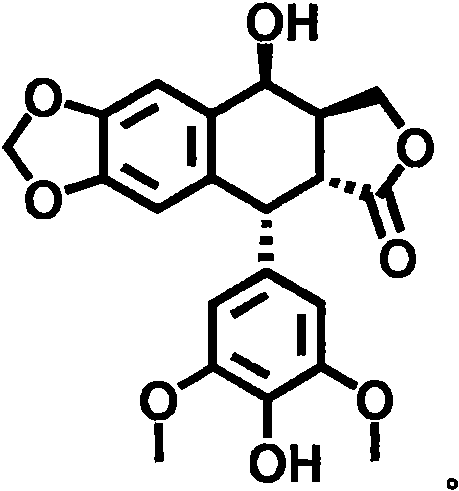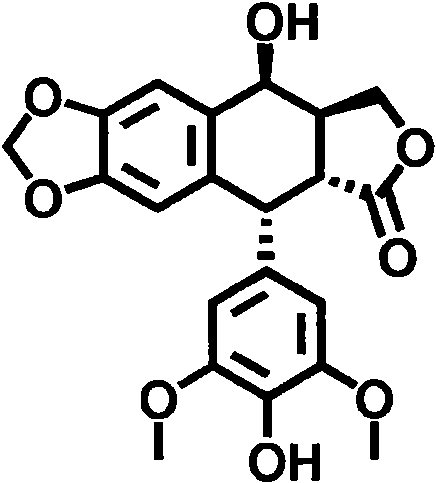Application of 4'-demethyl epipodophyllotoxin as agricultural bactericide
A technology for demethylating epipodophyllotoxins and toxins, which is applied in the field of pesticide applications and can solve problems such as reducing the targeting of compounds
- Summary
- Abstract
- Description
- Claims
- Application Information
AI Technical Summary
Problems solved by technology
Method used
Image
Examples
Embodiment 1
[0029] The inhibitory rate of 4'-desmethylepipodophyllotoxin on plant pathogenic bacteria was tested by turbidimetric method, and the test objects were bacterial blight of rice (Xoo), bacterial wilt of tobacco and canker sore of citrus (Xac). DMSO was dissolved in the medium as a blank control. Put the rice bacterial blight bacteria (the rice bacterial blight pathogen in the M210 solid medium) into the NB medium, shake and cultivate it in a constant temperature shaker at 28°C and 180rpm until the logarithmic growth phase is ready for use; put the tobacco bacterial wilt bacteria (in the M210 solid medium) M210 solid medium) was placed in NB medium, shaken and cultivated in a constant temperature shaker at 28°C and 180rpm until the logarithmic growth phase was ready for use; put X. citri (on M210 solid medium) into NB medium, Shake the culture in a constant temperature shaker at 28°C and 180 rpm until the logarithmic growth phase is ready for use. Add 5 mL of poisonous NB liqui...
Embodiment 2
[0036] Before the rice plants are used, the dead and old leaves are first subtracted, and the sample number is marked on the side of the pot with an oily marker before treatment, and the rice is neatly placed on the test bench; the spraying process is carried out with a watering can with a good atomization effect. It is advisable to require that the leaves of the plants can shed water droplets; try to ensure that two pots of healthy plants are tested for each drug; the cutting position is 0.5-1.0 cm away from the top of the rice, and 15-20 leaves are inoculated in each pot; the newly activated rice on the plate Add appropriate amount of Xanthomonas to NA medium, and cultivate overnight at 28°C and 180rpm until the turbidity of the medium is OD 595 =0.6 can be used for future use.
[0037] 1) Therapeutic activity:
[0038] First, at about 0.5-1.0cm of the leaves of healthy plants, use the scissors dipped in bacterial liquid to cut off the upper leaves at a slight angle, and di...
Embodiment 3
[0054] Before using the rice plants, cut off the dead and old leaves, mark the sample number on the side of the pot with an oil-based marker before treatment, and place the test materials neatly on the test bench; use a watering can with a good atomization effect for the spraying process , it is advisable to require that the leaves of the plants can shed water droplets; try to ensure that two pots of healthy plants are tested for each drug;
[0055] First, ensure that each liquid medicine corresponds to two pots of healthy plants, and spray about 25mL evenly on the front and back of the leaves of the two pots of rice until the water droplets evenly cover the surface of the leaves of the plants. The control group and the blank group were operated in the same way. After spraying, put the sprayed plants in an outdoor light-proof and ventilated place for about 1 hour. After the water droplets on the surface of the leaves are completely dry, put them in a light incubator with a tem...
PUM
 Login to View More
Login to View More Abstract
Description
Claims
Application Information
 Login to View More
Login to View More - R&D
- Intellectual Property
- Life Sciences
- Materials
- Tech Scout
- Unparalleled Data Quality
- Higher Quality Content
- 60% Fewer Hallucinations
Browse by: Latest US Patents, China's latest patents, Technical Efficacy Thesaurus, Application Domain, Technology Topic, Popular Technical Reports.
© 2025 PatSnap. All rights reserved.Legal|Privacy policy|Modern Slavery Act Transparency Statement|Sitemap|About US| Contact US: help@patsnap.com



